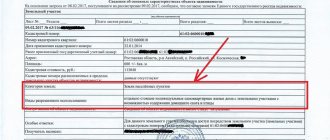The dacha amnesty has been extended. Putin signed the law on August 2, 2021. From now on, you can register a house on a summer cottage using a simplified procedure.
Attention! 12/08/2020 Law 404-FZ was adopted on the extension of the Dacha Amnesty until 2026 and on expanding the scope of its application - details.
Let's look at step by step how to register a house under the dacha amnesty.
Pitfalls you may encounter when designing a garden house
Often, citizens, turning to a cadastral engineer for registration of their country garden or residential building, find out that their plot is not demarcated and, along with the preparation of a technical plan, they need to fork out for land surveying. Read about why land surveying is needed in the article: “How land surveying is done.” When registering a country garden, residential building and other buildings, unforeseen circumstances may arise that prevent cadastral registration. Depending on the complexity of the situation, home registration may take several months or years.
We wrote about some additional nuances of delaying the cadastral registration of real estate in separate articles. List of articles by topic below:
Suspension of registration of ownership of real estate What is a cadastral error and how to correct it The disk in the MFC or Rosreestr cannot be read Extension of the dacha amnesty
General provisions for filling out the declaration form
For each registered object, its own declaration is filled out in two copies.
The declaration must be filled out by hand with a blue or black pen (ballpoint or fountain pen), legibly, without abbreviations. Abbreviations are allowed only in the form of a generally accepted abbreviation, for example, OVD, GUVD.
In places of the declaration where data is entered into specially provided cells (a set of cells), each cell must contain only one character (printed or non-printed) - a letter, a number, a punctuation mark, a space. The space between characters is provided by an empty cell.
If there is no data provided in the declaration, a dash is placed in the box. This applies only to those sections of the declaration that need to be completed in your particular case.
In the columns where a “V” (tick) sign indicates a choice from the options proposed by the declaration, choosing more than one option is not allowed.
The following will not be accepted for state registration:
- a declaration with damage that does not allow an unambiguous interpretation of the contents;
- declaration filled out in pencil;
- a declaration that has erasures or additions, crossed out words, and other unspecified corrections.
Showing a standard declaration (type of form) does not make much sense, but presenting the declaration form line by line with explanations may be useful to someone.
What does the new law give us?
First of all, register residential buildings that were built in violation of the setbacks and houses located in security zones (airfield areas, flood zones, power line zones, and so on). If previously, in order to register a residential building on the lands of individual housing construction or private household plots, you were required to send a notice of the planned construction of a residential building to the municipality, but now this is not necessary. After all, many citizens faced difficulties in registering their housing when the municipality sent notifications to plot owners about non-compliance with construction parameters. For example, when indentations were violated, the land user often had to resort to a judicial mechanism, by recognizing the ownership of an unauthorized building.
However, the introduction of a simplified procedure does not mean allowing the construction of houses in violation of urban planning standards. In particular, an individual residential building must meet the following parameters: a separate building with no more than three above-ground floors, no more than twenty meters in height, such a building is not intended to be divided into independent objects, such as apartments.
Is it now possible to build in security zones and violate the indentations?
The amendments cannot be regarded as an opportunity to violate protected zones and development and land use rules during the new construction of a residential building. As before, we recommend ordering an urban planning plan for a land plot (GPZU) before construction; the service is free, but the developer will know where he can build in accordance with the development rules.
IMPORTANT: The information letter of Rosreestr dated January 19, 2021 No. 13-00021/21 states that if a building is erected on a land plot after the approval and entry into force of the land use and development rules of the municipality, then failure to comply with the established indents entails the suspension of registration actions on a residential or garden house.
Thus, for the successful completion of cadastral registration and registration of a building, the declaration must indicate the date of construction of the building BEFORE approval of the development and land use rules. The declaration is an integral part of the technical plan and is signed by the owner of the land plot. The same principle applies to security zones. The date of entering information about the security zone into the Unified State Register will be of primary importance. So, if the declaration indicates that the house was built before the appearance of the security zone, then registration will be successful.
Program conditions
The dacha amnesty allows you to:
- Quickly legalize a building on a designated plot of land.
- Privatize the legalized building.
- Avoid significant financial expenses. Acting within the framework of this law, you will only need to pay a state fee for registering existing objects.
The following can take advantage of simplified registration:
- persons who have the right to perpetual use of an allocated plot of land;
- persons who have been granted a lifelong right to use a land plot;
- persons who own territory owned by a legal entity whose main activity is gardening or similar work.
Initially, the “dacha amnesty” program operated until March 1, 2015. However, the validity period of this law was not enough. Many people, for various reasons, did not have time to complete all the documents.
In February 2015, it was decided to extend the simplified registration of documents for the houses of owners of summer cottages, and for the plots themselves. For this purpose, the president of the country signed a special law extending the program until March 1, 2018 .
According to the law, it is possible to register ownership of plots that were once allocated for gardens, dachas, and individual housing construction. The house, garages, bathhouses and other buildings erected on them are also subject to registration.
However, it must be taken into account that this legislative act applies only to plots that were allocated or acquired before the adoption of the modern Land Code, that is, before October 30, 2001 .
To register any building on a plot of land under the “dacha amnesty” program, you must provide the registration authority with a minimum set of documents , the main one of which is a declaration for the property, which is drawn up according to the approved template.
Who draws up the declaration
This document must be drawn up by the owner of the property or his representative (in this case, clause 7.1 must be completed).
However, there are many nuances in its filling and design. Especially if you have a “non-standard” case or you don’t want to deal with filling it out at all. Therefore, it is advisable to contact specialists to fill out the declaration. And all you have to do is sign it. Our cadastral engineers usually fill out the declaration themselves. This way you can avoid filling errors. Next, the declaration is sent by mail to the Customer. He checks it, signs it, staples it and sends the scan to us.
What to do with a completed declaration
Since the technical plan is prepared and submitted electronically, the declaration must first be digitized. Simply put, scan. The electronic document must be in color with a resolution of at least 300dpi in PDF format. You need to scan all completed pages and be sure to scan the last one with the “stitched and numbered” sticker. Next, the scan must be sent to the cadastral engineer. Nobody needs the paper version. You can keep it for yourself as a memory.
Cost of preparing a technical plan
Residential or non-residential building
A declaration for a house under the dacha amnesty is drawn up both for residential buildings and for those that are unsuitable for habitation. The type of building is specified in the documentation. The building owner needs to understand the difference between the two options when filling out the form.
Criteria for residential construction:
- The presence of serviceable load-bearing structures that guarantee the reliability and safety of the structure.
- The absence of factors that cause harm to a person while indoors.
- Possibility to connect communications (gas, electricity, water, ventilation).
- Availability of an uninterrupted water drainage system.
- The level of noise and vibration does not exceed permissible values.
- The environmental situation excludes increased concentrations of substances hazardous to humans.
House unsuitable for habitation:
- The presence of harmful factors dangerous to life and health.
- The condition of the structure does not meet technical and construction standards.
- Low microclimate and non-compliance with sanitation standards.
- The building is located in a man-made disaster zone.
- The structure of the building has been changed as a result of an accident, fire or subsidence.
What information is contained in the declaration
The documentation reflects the following information:
- The first section contains information about the location of the property and address. If the plot is part of a gardening partnership, the full name of the cooperative is written down
- In the second section, the owner selects the type of property from several options (dacha, bathhouse, garage). The third section indicates the purpose of the property (residential or non-residential).
- The fourth column indicates the number of the plot and building assigned by the cadastre service.
- The fifth section contains information about the technical condition of the registered object. Detailed information is recorded, from the number of floors to the type of building materials used.
- The sixth section provides detailed information about the owner of the real estate (full name, residential address, INN, OGRN).
If the registered object is in shared ownership, information about the remaining owners of the building is entered in the seventh section of the form.
Registration of a house according to a declaration with the cadastral authorities follows a simplified procedure, but requires the collection of a package of documentation:
- passport of the property owner;
- technical documentation for construction;
- title documentation for the territory where the building is located;
- an extract from the state cadastre, which contains information about the site and buildings;
- cadastral plan of land and buildings;
- receipt of payment of state duty.
The declaration represents complete documentation, therefore the requirement of the registration authority to present additional documents outside the mandatory list is considered unlawful.







